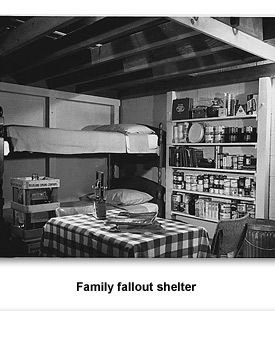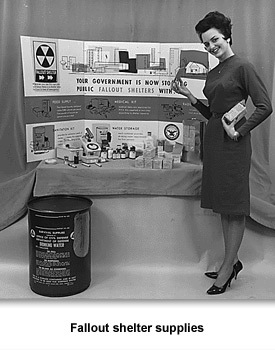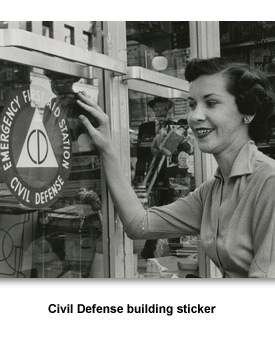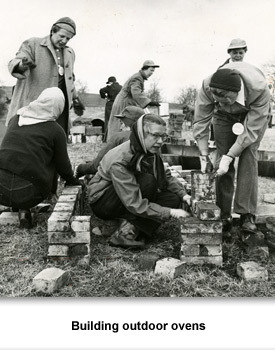Civil Rights / Cold War
Civil Defense
In response to the threat of nuclear war, state and federal government officials organized civil defense groups.
During the Cold War, civil defense was primarily seen as helping people who were not in the direct target area to survive a nuclear bomb.
Downtown buildings were designated as fallout shelters, while families were given information about making their homes safe from attack by building fallout shelters.
Read more about radioactive fallout from a government pamphlet.
Nuclear warning sirens were erected in cities to warn the surrounding neighborhoods of impending attack. The sirens would be periodically tested. Radio and television stations regularly interrupted their programming to run warning signals. The prerecorded announcement would say, "This has been a drill..." It is not surprising that Americans were fearful about a nuclear attack.
During the Cold War, civil defense was primarily seen as helping people who were not in the direct target area to survive a nuclear bomb.
Downtown buildings were designated as fallout shelters, while families were given information about making their homes safe from attack by building fallout shelters.
Read more about radioactive fallout from a government pamphlet.
Nuclear fear led to a new market for fallout shelters. Home economics classes taught girls how to stock such a shelter with food and supplies in the event of nuclear attack. The government created official films on shelters, praising their value and advising homeowners on how to use them. Dig Deeper: Would drills and fallout shelters really have protected lives?
At school, children were taught to hide under their desks in the case of a nuclear attack. They even had practice drills. Office buildings and schools were designated as Civil Defense fallout shelters. Watch a program from the 1950s about Civil Defense.
At school, children were taught to hide under their desks in the case of a nuclear attack. They even had practice drills. Office buildings and schools were designated as Civil Defense fallout shelters. Watch a program from the 1950s about Civil Defense.
Picture Credits:
- This 1950s government photograph showed how families could put a fallout shelter in the basement of their homes. The caption states that this would include a 14-day food supply, a battery-operated radio, auxiliary light sources, a two-week supply of water, and first aid, sanitary, and other supplies. National Archives and Records.
- This government photograph uses a female model to show what kinds of supplies need to be kept in a fallout shelter. The can on the floor says drinking water and has the Civil Defense emblem on the side. National Archives and Records
- Photograph of a volunteer Civil Defense worker, Bobbie Jean Underwood, attaching the first Civil Defense building sticker on the door of a downtown drugstore. The sticker tells the public that the store will serve as an emergency first aid station in the event of an emergency. The photograph was taken by Jack Corn in 1955. Courtesy of The Tennessean
- Volunteers, described in the newspaper files as home economists, learn how to build outdoor ovens in Nashville in 1954. Photograph by Terry Tomlin, Courtesy of The Tennessean
Civil Rights / Cold War >> Cold War >> Threat of Nuclear War >> Civil Defense




 Sponsored by: National Endowment for the Humanities
Sponsored by: National Endowment for the Humanities